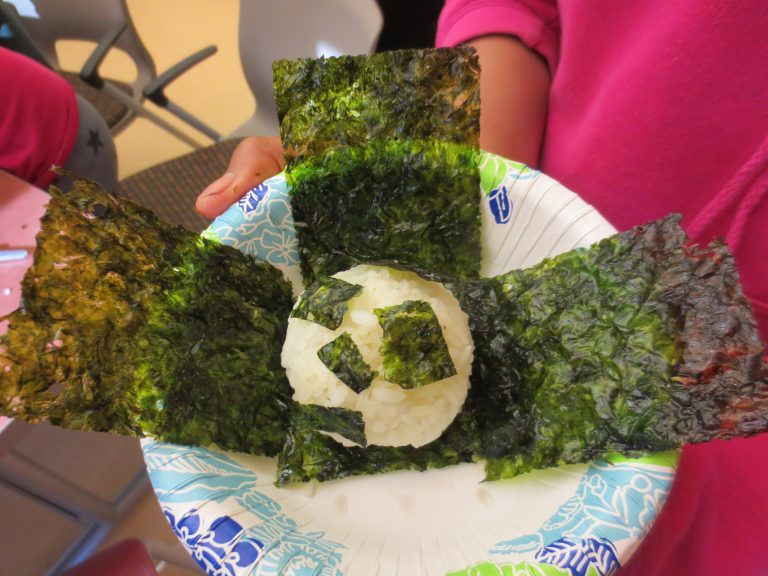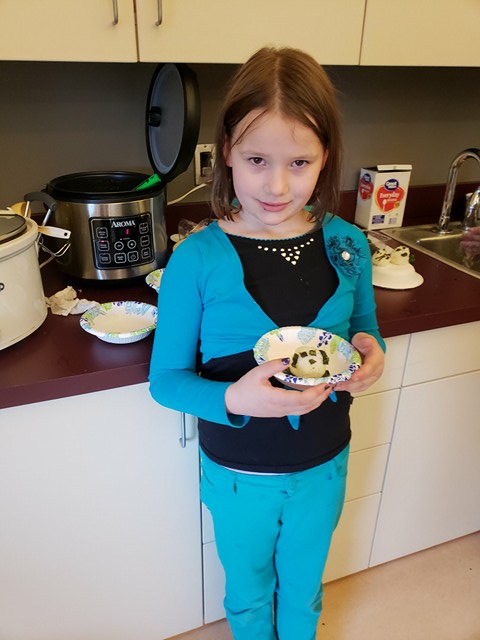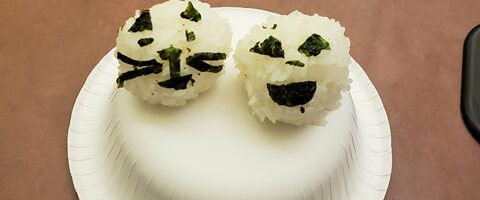
Happy little onigiri!
For my last project of the semester, I really wanted to give a presentation to kids. Fortunately, the Children’s Librarian in the Ketchikan Public Library agreed to let me give a talk on about our local seaweed species to kids. We talked a few weeks ahead of time and decided that a three part presentation would work the best for the age range of 3-14 years of age. Quite a broad group to cover and keep engaged! The night of the presentation, I was thrilled to see that I had thirty kids who had shown up on a sunny afternoon to learn about seaweed.
The first part of my presentation included containers of seaweed that I had foraged and kept in sea water the day before. Because seaweed is so perishable, I kept it in the fridge until show time. For this presentation, I gathered: Fucus distichus subsp. evanescens (C. Agardh) H.T. Powell, Neurocystis leutkeana (K. Mertens) Postels et Ruprecht, Saccharina latissima (Linnaeus) C.E. Lane , Palmaria mollis (Setchell et N.L. Gardner) van der Meer et C.J. Bird, Condracanthus exasperates (Harvey et Bailey) Hughey, Neodilsea borealis (I.A. Abbott) S.C. Lindstrom, and Ulva lactuca Linnaeus.

I used simple concepts with the kids, to make sure that I didn’t lose the toddler faction of the group. I talked about the three color groups that seaweed species are put into: brown, red, green. Using the tubs as an example, I could also show that brown seaweed species are our most common and green ones are the least common. Then the group was invited to line up and touch and feel the different seaweed specimens. The younger ones really loved the bumpiness of the sugar kelp and Turkish towel species. Most kids loved the bull kelp and a couple of the kids shared stories of either chasing a sibling or being chased by a sibling with bull kelp.
Next it was time for “seaweed magic”. In her book, Common Edible Seaweeds in the Gulf Alaska, Dr. Dolly Garza describes an experiment in which you take a piece of Fucus distichus, (Popweed) and dip it into boiling water. When held in the boiling water, it turns from a golden olive brown to a bright green (Garza, 2005: pg. 13) . I brought my portable kettle and while we were waiting for the water to boil, one of the children asked if there were any poisonous species of seaweed.
I had recently interviewed Barbara Morgan on this subject and she let me know that there are only a handful of seaweed species that are considered inedible. Barbara teaches Coastal Resources at UAS Ketchikan. She told me that the first inedible species is Desmarestia ligulata (Stackhouse) J.V. Lamouroux and the other are the species from a family known as Corallinaceae. I assured him that if he encountered the former, he would never want to eat it because it smells like rotten eggs. This caused great disgust amongst my attendees and many exclamations of “Ewwwwww!” It also disintegrates quickly when exposed to the air, so it is very rare to even find it at a low tide. The other ones belonging to the Corallinaceae family are crunchy like eating seashells, so again, you would never want to eat them (Morgan, 2018).
Now the water was at a boil and I dipped the leaf. Below is a link to my video of me showing a few kids who came late to the presentation. Sure enough, it turned bright green and the children seemed very impressed! A couple of kids wanted to taste the seaweed and as you will see from the end of the video, it was NOT one girl’s favorite thing!

Making Onigiri
Our last activity was to make an edible seaweed snack. We used purchased seasoned nori sheets and made Japanese rice balls, called onigiri. I wanted to give the kids the chance to taste seaweed in a fun atmosphere. I have also seen with my own children that they are more likely to eat something that they make.
Onigiri recipe
2 cups of sushi rice (I used Calrose)
2.5 cups of water
seasoned nori sheets
salt
Combine in rice cooker and cook as directed.
Wet your hands and sprinkle very lightly with salt, this will give it a little flavor and keep it from sticking. Take a scoop of warm rice (let it cool down a little!) and in your damp hands shape it like you would a small snowball. Cut the nori sheets into shapes that are fun and use them to decorate your rice ball!

Why do a project like this?
Studies have shown that when children are given environmental education, it fosters connectedness to nature (Ernst & Theimer, 2011: pg. 578). My hope is that through programs like these, we can help children care about our ecosystem. Because we live in a society where kids more frequently are indoors and engaging with technology, environmental education researchers say that “environmental education at an early level is proposed as a partial antidote to this concern” (Wilson, 1996: pg. 2). Still another study, (this one conducted in Alaska) proposes that children who have the attributes of “Trust in Nature, Spatial Autonomy, and Environmental Competency (which) all serve to inform a child’s willingness to act to conserve and care for their environment” (Green, 2017: pg 317). Trust in Nature is the quality of understanding Nature’s ability to provide sustenance for living creatures. Spatial Autonomy is the ability to be in nature and “establish connections with water, plants, and animals” (Green, 2017: pg 303). Environmental Competency is the ability to understand different environmental concepts, such as ecology and the food web.
All of the research mentioned above reinforces the idea that it is best to teach kids early about nature and to help them to feel connected to nature.
I am planning on teaching about Southeast Alaska’s wild berries in August.
References:
Ernst, J., & Theimer, S. (2011). Evaluating the effects of environmental education programming on connectedness to nature. Environmental Education Research, 17(5), 577-598. Retrieved from https://egan.ezproxy.uas.alaska.edu/login?url=https://search.ebscohost.com/login.aspx?direct=true&db=eric&AN=EJ950203&login.asp&site=ehost-live https://dx.doi.org/10.1080/13504622.2011.565119
Garza, D. A. (2005). Common edible seaweeds in the gulf of Alaska. United States: Retrieved from https://catalog.hathitrust.org/Record/008329540
Green, C., cjgreen2@alaska.edu. (2017). Children environmental identity development in an alaska native rural context. International Journal of Early Childhood, 49(3), 303-319. 10.1007/s13158-017-0204-6 Retrieved from https://egan.ezproxy.uas.alaska.edu/login?url=https://search.ebscohost.com/login.aspx?direct=true&db=eft&AN=126970173&login.asp&site=ehost-live
Morgan, B. (2018). Interview with Barbara Morgan. Ketchikan, Alaska.
Wilson, R. A. (1998). Starting early: Environmental education during the early childhood years. ERIC Clearinghouse for Science Mathematics and Environmental Education, ERIC Identifier: ED402147 Retrieved from: https://www.ericdigests.org/1998-1/early.htm
Posted: 2017



